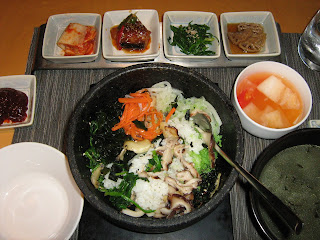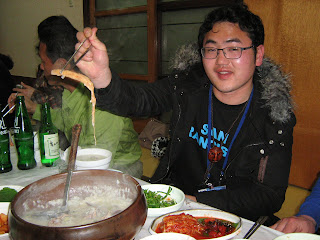Our first famished night in Korea, we picked a random restaurant. Here's what we were served:

See the lovely lavender octopus tentacle. Our relationship to octopus evolved a little during the trip, with most of us agreeing that it was tolerable, one of us swearing it off for life, and two of us eating it raw, straight out of the tank. Below is a seafood item that appeared in a steaming bowl of soup.

We figured it looked a little like an octopus' private parts, until Duwayno corrected us on the technicalities of octopus anatomy and mating methods. We still don't know what this piece of seafood really was.
Many times, strolling through the seaside towns of southern South Korea, we'd spy a tank of these creatures, which we lovingly dubbed "hot dogs with mouths."

Although I could not bring myself to eat one of these, raw or cooked, I admit that they are probably more pure than any American hot dog.

Above is another unattractive entree: boiled chicken with roots and bean sprouts. Though it was quite good with rice soup on a chilly spring day.

Here's an item we all liked: sweet potato noodles. They go down very easy.

Koreans don't eat dessert in form of refined sugar or flour. No wonder they lack love handles. If you're lucky, at the end of a meal, you get candied potatoes with sesame seeds and super-sweet mandarin oranges. I inhaled these as often as possible.

The presentation of food on the Korean table is often spectacular. Above: check out this stunning little bowl of pink chilled soup: a spring gazpacho, if you will, with pickled turnips.

A meal in Korea is nothing if not a social occasion. Here is Mr. Park, a fun-loving Rotarian in Tongyeong, handling the cooking duties at our table. He's frying thin strips of beef, which you eat with green onions, a sliver of roasted garlic, and a sweet pepper sauce, that you wrap up in a lettuce leaf. I'm going to miss having a grill at my table, and the way the Korean people wanted to be sure our bowls were never empty.

Here's a close-up, along with some pickled turnip slices and a cole slaw with a pastel plum dressing.

There are some great spreads out at the markets. Here's where it all comes from.

As much as I love Korean food, I was jonesing for some American breakfast food and during our weekend in Seoul, found a brunch spot and almost cried from bliss over these pancakes with ricotta, fig and walnuts. And kiwi juice to drink.

We also ate a Hilton hotel, but I decided to order Korean food: I figured it was going to be good, and it was: beebimbap: a mixture of rice, seaweed, mushrooms and other goodies.

This platter of rice "tortillas" surrounded by delicate fillings won big points for aesthetics. I asked if the chef could come out so we could give her a round of applause.

A common favorite on the Korean table are these savory little pancakes, made (I surmise) with rice flour, spinach and egg. To be dipped in sesame oil. I'm going to try making these at home.

I didn't think I was a big fan of duck until this platter of smoked quack-ers came out.

A meal's second course is often a soup of some sort. In this case, a seafood concoction with ginseng. Our interpreter, Mr. Kang, was probably sick to death of me asking what food was what.
Here's what I will remember about Korea: the great meals to which we were treated, the unprocessed nature of the food and its bold flavors, the strong desire of Koreans to share their cuisine, and the conviviality at each meal that needed no translation.


No comments:
Post a Comment